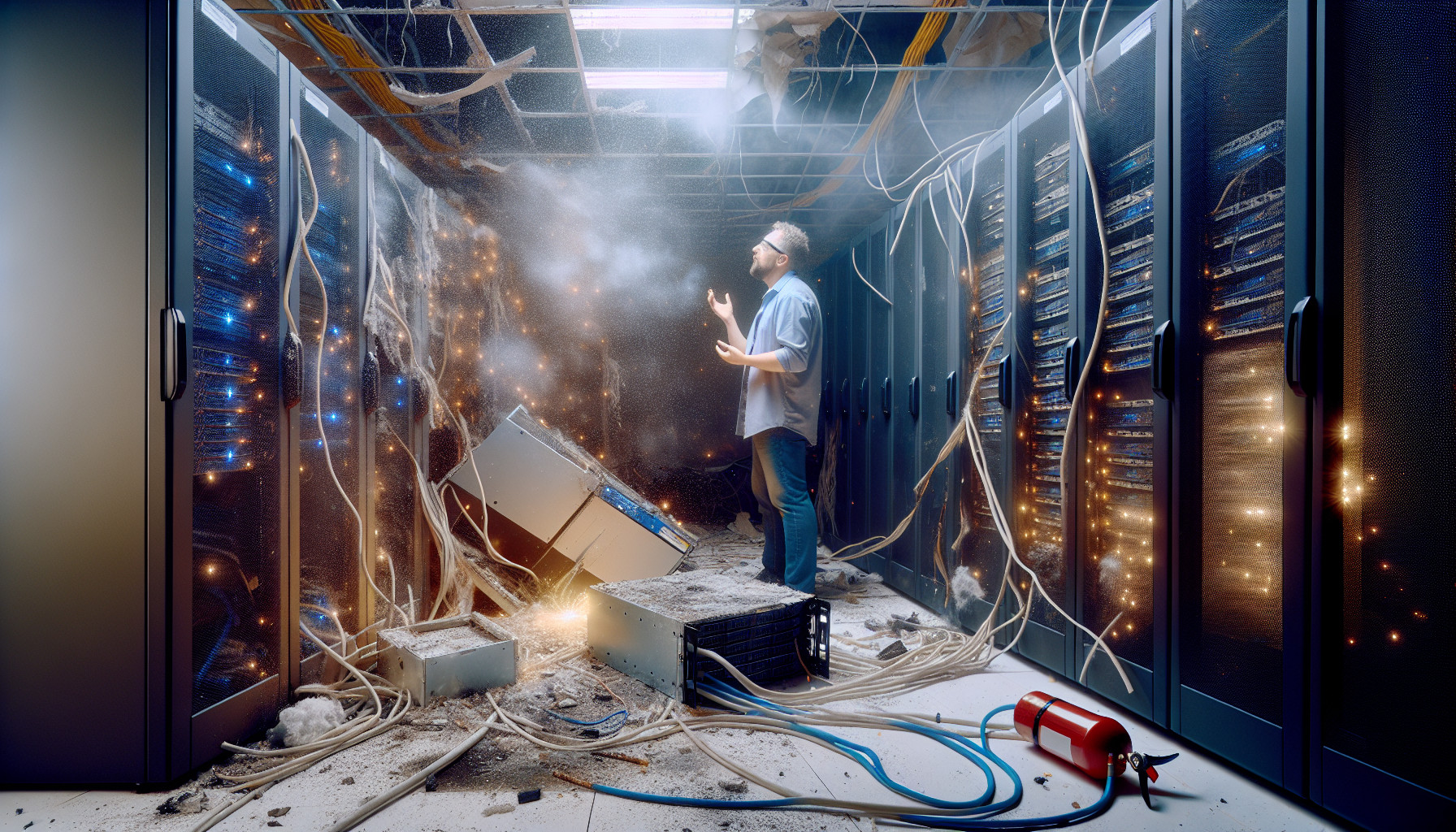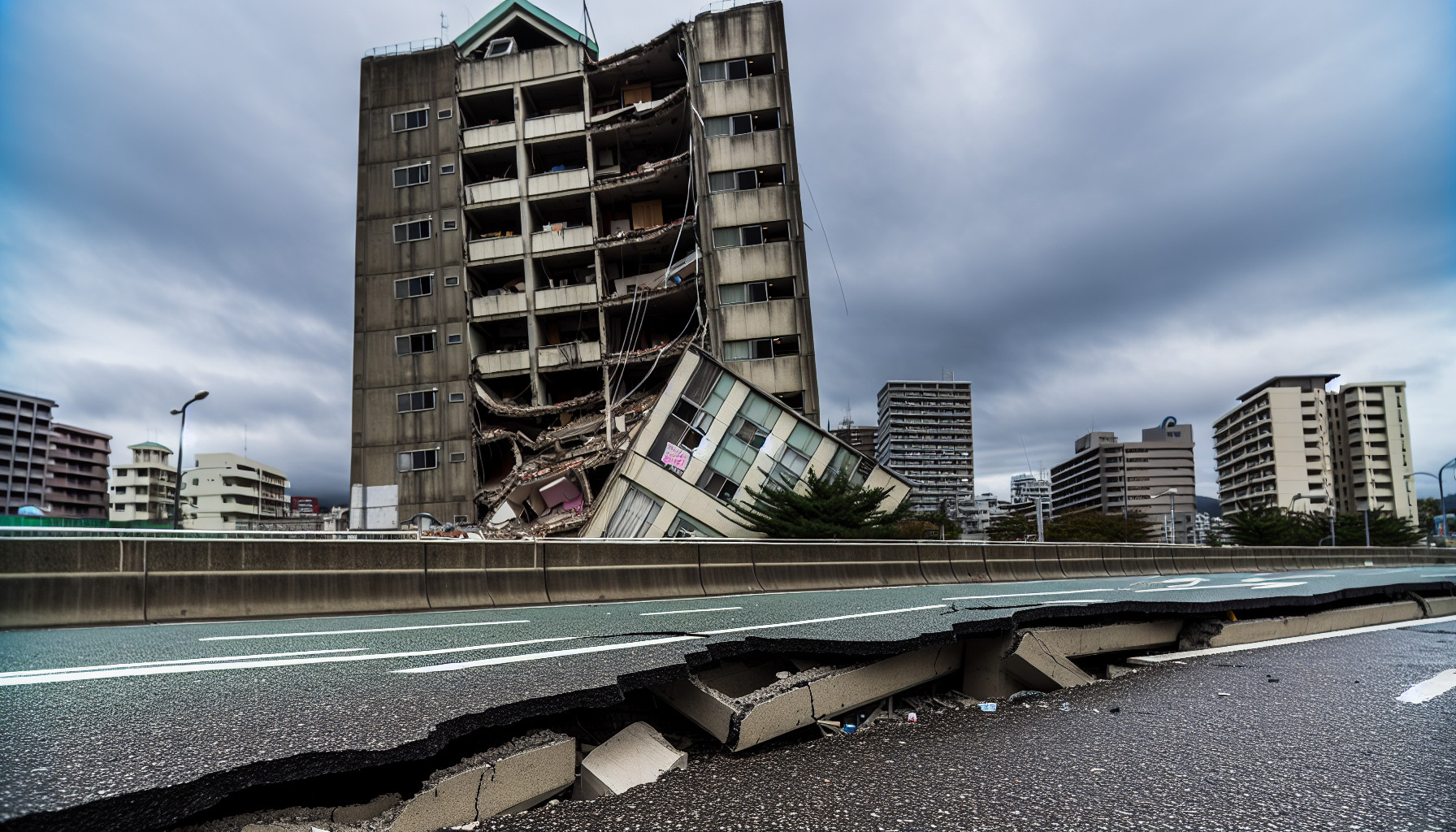
Are you equipped to protect your sensitive information from physical threats? Understanding and combating physical threats to information security are paramount for any organization. This involves more than just digital safeguards; it’s about preventing unauthorized access, theft, and damage due to environmental disasters.
In this article, you’ll learn about the most pressing physical security threats and risks and the practical measures to counteract them, ensuring the safety and integrity of your data and systems.
Key Findings on Physical Security Threats to Computer Systems
-
Lapses in physical security can have dire consequences, ranging from data breaches and loss of sensitive information to infrastructural damage. Implementing access controls and employee training is crucial to prevent unauthorized access and mitigate social engineering attempts.
-
Environmental hazards such as fire, floods, and earthquakes pose substantial risks to information security. Preparing for these threats involves comprehensive risk assessments and implementing specialized infrastructure protections, such as fire suppression systems and earthquake-proof measures.
-
Theft, vandalism, and sabotage can critically affect an organization, necessitating robust security controls like intrusion detection systems and disaster recovery plans. Regular updates, maintenance, and employee training are fundamental to adequate physical security.
The Dire Consequences of Ignoring Physical Security

The potential ramifications of failing to implement physical security measures can be significant, encompassing data breaches, loss of sensitive information, and damage to infrastructure.
One of the most common physical security threats is unauthorized individuals attempting to gain physical access to a machine. Guarding against this risk is vital for system security.
Access controls, or devices such as anti-tailgating devices, doors, visitor passes, and strategically positioned barriers, increase the difficulty for unauthorized individuals to access valuable assets and prolong the time required for attackers to carry out acts like theft, vandalism, or terrorism. Employees must undergo physical security training to comprehend, identify and abide by these access control measures.
These security measures also prevent unauthorized individuals from gaining physical access to sensitive areas and information.
Testing, a significant part of this framework, validates the effectiveness of policies and procedures while minimizing the likelihood of errors during actual incidents. However, even the best access control measures can be undermined by social engineering.
Some examples of social engineering include:
-
The ‘coffee trick’ in which an individual manipulates another to grant unauthorized physical access
-
Phishing attacks where individuals are tricked into revealing sensitive information through deceptive emails or websites
-
Tailgating, where an unauthorized person follows an authorized person into a secure area without proper authentication
Awareness of these tactics and educating employees on recognizing and responding to social engineering attempts is essential.
Unseen Dangers: Environmental Hazards to Information Security

Environmental hazards such as natural disasters, including fire, floods, and earthquakes, pose significant threats to information security. These unseen dangers can disrupt operations, damage facilities, and even compromise sensitive data, highlighting the need for robust physical security measures to withstand these threats.
We will now examine these hazards more thoroughly.
Fire and Information Security
Fire is a potential threat that can cause catastrophic damage to IT infrastructure. Fire has the potential to:

-
Cause the destruction of data centres and computer equipment
-
Disrupt communication
-
Significantly impact critical infrastructure sectors such as transportation and power services.
The sensitive media and equipment within the IT infrastructure, including critical systems and computer systems, are especially prone to fire damage, and their safeguarding is indispensable for maintaining information security integrity and network security.
Preventing fires necessitates a comprehensive fire risk assessment of all computer systems and server rooms and implementing measures like anti-virus software and a ‘digital fire extinguisher’. Gas suppression systems and waterless clean agent, fire suppression systems, are highly recommended in IT environments because they protect sensitive electronic equipment without causing damage.

Cyber Essentials Plus Certification
- Protect sensitive data, protect your business
- Improve eligibility for new opportunities across regulated industries and public sector.
Floods and Earthquakes: Preparing Facilities

Floods and earthquakes pose a significant threat to information security. They can cause data loss, IT infrastructure damage, and power disruptions. This can jeopardize the security of confidential information.
Preparation for these natural disasters often involves several steps. These include implementing flood prevention measures and conducting hazard assessments. It also consists of creating an emergency plan and practising safe earthquake procedures.
A disaster response plan is crucial. It involves establishing a team of employee representatives and identifying hazards. It also requires creating a preparedness plan and testing it regularly.
However, common errors in disaster preparation exist. These include presuming that staff is adequately trained and ineffective communication during an event. Conducting inadequate drills and relying on obsolete emergency plans are also common mistakes.
When Accidents and Malice Strike: Addressing Theft, Vandalism, and Sabotage

Accidents, theft, vandalism, and sabotage aren’t just plot elements in a Hollywood thriller; they’re real-life occurrences that pose significant physical security threats. These events can result in the loss or damage of sensitive information, disruption of operations, and considerable financial losses.
We will now discuss practical ways to address these threats.
Preventing Theft of Sensitive Information
The theft of sensitive information is a significant risk that organizations face. If unauthorized individuals gain access to sensitive documents, the results can be catastrophic. Hence, access control is pivotal in preventing unauthorized individuals from entering the workplace and potentially making off with sensitive documents. A clear-desk policy can reduce the likelihood of sensitive documents being left unattended and susceptible to theft.
Moreover, sensitive documents and files which are no longer needed should be shredded by authorized employees to eliminate the risk of theft or unauthorized access to files. Additionally, encryption tools can protect sensitive information by converting it into an unreadable format, preventing unauthorized access and ensuring the data remains unintelligible to unauthorized parties.
Mitigating Vandalism and Sabotage Risks
Vandalism and sabotage are equally damaging, while perhaps less common than theft. They can disrupt operations, damage property, and impact a company’s reputation. To effectively reduce the risk of vandalism in the workplace, the following steps are essential:

-
Understand the motives behind such acts.
-
Foster a positive workplace culture.
-
Implement robust security measures.
-
Monitor for suspicious activities.
By following these steps, you can help your office protect your workplace or office from vandalism and sabotage.
Intrusion detection systems play a crucial role in mitigating vandalism and sabotage by:
-
Monitoring for unauthorized entries or suspicious behaviours using a range of sensors and surveillance equipment
-
Setting off alarms
-
Notifying security personnel
-
Initiating response measures to address potential threats promptly
These systems aid in the prevention of acts of vandalism and sabotage.
Bridging the Gap in Defenses: Strengthening Weak Access Controls
Weak access controls can serve as a gateway for threat actors to infiltrate your organization. Attackers can gain unauthorized access to secure areas and compromise sensitive data by tailgating or exploiting outdated access control systems.
We will now discuss how to strengthen these potential vulnerabilities.
Secure Areas and Access Control Upgrades
Secure areas are the heart of your organization’s operations, housing critical systems and sensitive information. This is why these areas must have robust access controls in place. Access control is essential to hindering unauthorized individuals from entering the workplace and potentially taking sensitive documents. However, just having an access control system in place isn’t enough. Regular reviews and upgrades to computer systems are necessary to ensure these systems are keeping pace with evolving threats.
There are various types of access control systems, including:
-
Electronic door locks
-
Keypads
-
Key fob and critical card systems
-
Biometric access
-
Proximity and wireless access controls
These systems ensure that only authorized individuals can access sensitive locations, protecting against potential threats.
Upgrading and enhancing these systems is significant for information security. It addresses evolving security threats, strengthens defence against unauthorized access, and ensures that software security measures are up-to-date and effective in protecting an organization’s sensitive areas and assets.

Cyber attacks are not a matter of if, but when. Be prepared.
Box-ticking approach to penetration tests is long gone. We help you identify, analyse and remediate vulnerabilities so you don’t see the same pentest report next time.
The Blueprint for Safety: Conducting Comprehensive Risk Assessments
To effectively manage physical security threats, organizations need a blueprint for safety. This blueprint is a comprehensive risk assessment that includes:
-
Identifying, analyzing, and prioritizing physical security vulnerabilities
-
Conducting a thorough analysis of an organization’s facilities, security risks, and physical security practices
-
Assessing facilities, practices, and assets
-
Pinpointing specific risks
-
Implementing proactive measures to address them
A comprehensive risk assessment in physical security enables organizations to assess their facilities, practices, and assets, pinpoint specific risks, and implement proactive measures to address them.
The procedural steps for conducting a comprehensive risk assessment for physical security involve auditing the physical site or facility, auditing operating procedures, auditing biological security systems, and identifying the risks.
A comprehensive risk assessment, which methodically evaluates specific threats and identifies exploitable vulnerabilities, is fundamental in pinpointing physical security vulnerabilities. The danger and process can be identified using various tools and methodologies, such as quantitative, qualitative, semi-quantitative, asset-based, vulnerability-based, and threat-based approaches.
Fortifying Your Fortress: Deploying Robust Physical Security Controls
Once vulnerabilities and risks have been identified, the next step is to fortify your fortress by deploying robust physical security controls. These controls include:
-
Access control systems
-
Intrusion detection systems
-
Environmental monitoring
-
Disaster recovery plans
These controls serve as your organization’s shield to protect employees against physical security threats.
Intrusion Detection Systems: The First Line of Defense
Intrusion detection systems are the first defence against unauthorized access and potential security breaches. An intrusion detection system is a security mechanism specifically designed to detect unauthorized entry into a protected area or facility, assisting security teams in verifying security breaches and enhancing response time.
The various hardware categories of intrusion detection systems comprise Signature-Based Intrusion Detection Systems (SIDS), Network Intrusion Detection Systems (NIDS), Host Intrusion Detection Systems (HIDS), and Protocol-based Intrusion Detection Systems (PIDS). The primary hardware constituents of an intrusion detection system encompass sensors, analyzers, management servers, database servers, and a console.
Intrusion detection systems (IDS) effectively prevent unauthorized network access by detecting patterns and analyzing network traffic. They offer enhanced visibility across the network to protect it and aid in compliance with security regulations. IDS can accurately detect and respond to eliminate threats and false positives.
Disaster Recovery Plans: Ensuring Business Continuity
In a physical security incident, disaster recovery plans ensure business continuity. Disaster recovery plans guarantee business continuity during physical security incidents by implementing clearly outlined and actionable procedures for resilience and recovery.
One of the critical elements of such plans is the presence of data backups and redundant systems. These systems ensure that in the event of a compromise to one backup, multiple copies are stored in different locations to facilitate data restoration and uphold business continuity.
It’s vital to test and update disaster recovery plans regularly. Here are some critical practices for maintaining effective disaster recovery plans:
-
Regular testing
-
Meticulous documentation of tests
-
Testing both the disaster recovery solution and personnel
-
Reviewing and regularly updating the plans
-
Establishing a communication plan
-
Staying updated on the latest trends and best practices in physical security
Empowering Defenders: The Role of Employee Training in Security
As an organization’s first line of defence, training employees to empower them is critical to physical security. Increasing awareness about physical security among employees and motivating them to defend their workplace proactively is the most effective approach to combating physical security threats.
The Physical Security Staff Awareness E-learning Course provides a thorough 45-minute training that improves employees’ comprehension of their duties when dealing with sensitive information and the proactive steps they can take to monitor and mitigate security threats. Cyphere offers such services to customers where strategic input is provided after an initial understanding of requirements and current controls.
Educating employees about the significance of IDs and proper access management is also crucial. It can prevent the sharing or lending access cards, ensure accurate access monitoring, and maintain secure control over sensitive areas.
Maintenance and Vigilance: Keeping Security Systems Current
Like any other computer system, security systems need regular maintenance and updates. Regularly maintaining and updating security systems allows businesses to detect issues early, ensure the computer system’s reliability and performance, and spot faults before they become significant problems. It is advisable to refresh IT infrastructure every 3-5 years.
Effective maintenance and updating of physical security systems recommend implementing the following measures:
-
Physical entry controls
-
Regular monitoring and updating of the security system
-
Recording equipment details
-
Training employees on physical security protocols
-
Setting up a centralized record system for auditing and documentation
-
Staying updated on physical security trends and practices
-
Reviewing and updating security policies and procedures
-
Incorporating a layered security approach.
Cyber-Physical Threat Evolution: Understanding the Interconnected Risks
Technological evolution and increased connectivity have blurred the lines between physical and cyber threats, leading to cyber-physical threats. A cyber-physical threat is an incident that targets interconnected digital and biological systems, presenting a heightened level of risk.
The association between physical and cyber threats has evolved due to technological progressions such as cloud infrastructure and the enhanced connectivity of devices, resulting in new vulnerabilities and the transformation of security threats.
Instances of non-physical threats encompass viruses, Trojans, and worms. Their impact can be reduced by implementing anti-virus software, regulating the use of external storage devices, and limiting access to websites that may facilitate the download of unauthorized programs.
Robust authentication methods like user IDs, strong passwords, smart cards, or biometric systems can help organizations lessen unauthorized access.
Vetting the Gatekeepers: Securing the Supply Chain
The supply chain is a critical aspect of an organization’s operations, and securing it is vital for maintaining robust physical security.
Prevalent physical security risks in supply chains encompass a lack of visibility and control over inventory, vulnerabilities or breakdowns within the supply chain, supply chain attacks that compromise organizations, and insufficient system security or malicious insiders.
Vendors and third-party service providers can present a physical security threat by serving as a point of entry for unauthorized access, potentially causing damage to a company’s reputation in the event of service failure and exposing the company to financial, regulatory, and intellectual property vulnerabilities.
The term vetting in the context of securing a supply chain encompasses:
-
Prioritization of risks
-
Collection of supplier information
-
Assessment of risk factors
-
Development of strategies to address them
-
Implementation of third-party risk assessments to safeguard the overall security of the supply chain
Evaluating the physical security of a third-party service provider is significant in ensuring the security of the supply chain as it facilitates communication with vendors to establish a culture of security and compliance, thereby preventing incidents in the long term.
Summary
Physical security is a multifaceted discipline and organization that goes beyond managing visible threats. It includes handling unseen environmental risks, accidental incidents, and deliberate malicious actions. The process involves enhancing access controls, undertaking thorough risk assessments, implementing sturdy physical security measures, educating personnel, and continuously updating security systems.
Recognizing the intertwined nature of physical and cyber threats, as is securing the supply chain, is also vital. Partnering with a third-party company like Cyphere to audit your controls can offer valuable strategic insights. By embracing these measures, businesses can safeguard their critical systems, confidential and sensitive data, reputation, and sustainability.
Frequently Asked Questions
Which one is the physical security threat?
Forced entry or break-ins, vandalism and property damage, unauthorized entry devices, natural events, extreme temperatures, and intentional acts of destruction are physical security threats. Be aware of these threats to ensure proper security measures.
What are the four types of physical threats in a network?
A network’s four physical threats are hardware, environmental, electrical, and maintenance. Malware refers to malicious software designed to damage, disrupt, or steal.
What are the physical barriers to information security?
Physical barriers in information security include fences, walls, doors, locks, and gates, all of which prevent physical access to a building and deter potential intruders. They define the perimeter of the facility and make intrusions seem more difficult.
What are the potential consequences of ignoring physical security?
Ignoring physical and network security can lead to data breaches, loss of sensitive information, and damage to infrastructure, which can have severe consequences for an organization.
What role do intrusion detection systems play in mitigating vandalism and sabotage?
Intrusion detection systems are crucial in mitigating vandalism and sabotage by detecting unauthorized entries or suspicious behaviours and promptly addressing potential threats.
Harman Singh is a security professional with over 15 years of consulting experience in both public and private sectors.
As the Managing Consultant at Cyphere, he provides cyber security services to retailers, fintech companies, SaaS providers, housing and social care, construction and more. Harman specialises in technical risk assessments, penetration testing and security strategy.
He regularly speaks at industry events, has been a trainer at prestigious conferences such as Black Hat and shares his expertise on topics such as ‘less is more’ when it comes to cybersecurity. He is a strong advocate for ensuring cyber security as an enabler for business growth.
In addition to his consultancy work, Harman is an active blogger and author who has written articles for Infosecurity Magazine, VentureBeat and other websites.












